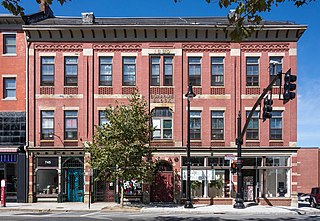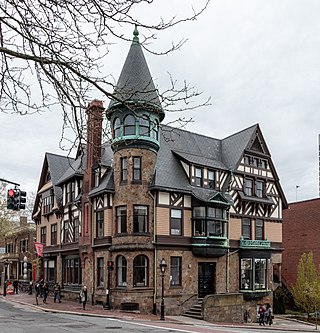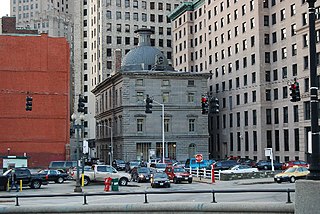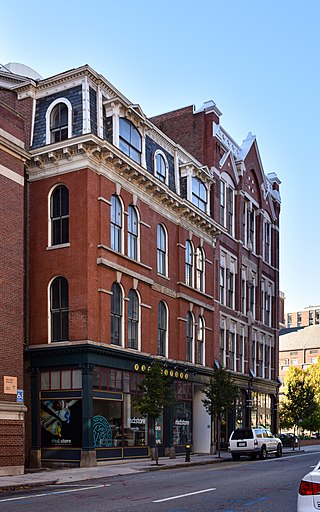
The Rhode Island School of Design is a private art and design school in Providence, Rhode Island. The school was founded as a coeducational institution in 1877 by Helen Adelia Rowe Metcalf, who sought to increase the accessibility of design education to women. Today, RISD offers bachelor's and master's degree programs across 19 majors and enrolls approximately 2,000 undergraduate and 500 graduate students. The Rhode Island School of Design Museum—which houses the school's art and design collections—is one of the largest college art museums in the United States.
The year 1917 in architecture involved some significant architectural events and new buildings.

York and Sawyer was an American architectural firm active between 1898 and 1949. The firms' work is exemplary of Beaux-Arts architecture as it was practiced in the United States. The partners Edward York and Philip Sawyer (1868–1949) both trained in the office of McKim, Mead & White in the 1890s. In 1898, they established their independent firm, based in New York City.

The Industrial Trust Building, located at 111 Westminster Street or 55 Kennedy Plaza in downtown Providence, Rhode Island, was built in 1928 as the Industrial Trust Co. Building, and was designed by the New York firm of Walker & Gillette. At 428 feet (130 m) with 26 floors, it is the tallest building in Providence and the state of Rhode Island, and the 28th tallest in New England; when it was completed it stood several stories higher than the recently finished Biltmore Hotel nearby.

College Hill is a historic neighborhood of Providence, Rhode Island, and one of six neighborhoods comprising the city's East Side. It is roughly bounded by South and North Main Street to the west, Power Street to the south, Governor Street and Arlington Avenue to the east and Olney Street to the north. The neighborhood's primary commercial area extends along Thayer Street, a strip frequented by students in the Providence area.

The Redwood Library and Athenaeum is a subscription library, museum, rare book repository and research center founded in 1747, and located at 50 Bellevue Avenue in Newport, Rhode Island. The building, designed by Peter Harrison and completed in March 1750, was the first purposely built library in the United States, and the oldest neo-Classical building in the country. It has been in continuous use since its opening.

Downtown is the central economic, political, and cultural district of the city of Providence, Rhode Island, United States. It is bounded on the east by Canal Street and the Providence River, to the north by Smith Street, to the west by Interstate 95, and to the south by Henderson Street. The highway serves as a physical barrier between the city's commercial core and neighborhoods of Federal Hill, West End, and Upper South Providence. Most of the downtown is listed on the National Register of Historic Places as the Downtown Providence Historic District.

The Burrows Block is an historic commercial building at 735-745 Westminster Street in Providence, Rhode Island. It is a three-story brick building with Gothic Revival styling. It was built in 1880 by Caleb Burrows to provide office space for his hardware business, with retail spaces on the ground floor. Although the hardware business declined in the 20th century, the building has seen a variety of commercial and retail tenants, and was purchased by the city in 2002.

The Dr. George W. Carr House, also known simply as Carr House, is a historic house at 29 Waterman Street in the College Hill neighborhood of Providence, Rhode Island. The Queen Anne style house was built in 1885 by Edward I. Nickerson and added to the National Register of Historic Places in 1973.

The Customhouse Historic District is a historic district encompassing fifteen historic buildings in downtown Providence, Rhode Island. The district is bounded by Westminster, Exchange, Dyer, Pine, and Peck Streets, and includes eight buildings associated with the important functions of the business center Providence became in the mid-to-late 19th century. It was listed on the National Register of Historic Places in 1975, and is completely contained within the Downtown Providence Historic District, listed in 1984.

Hope Block and Cheapside are two historic commercial buildings located at 22-26 and 40 North Main Street in the College Hill neighborhood of Providence, Rhode Island. The Hope Block was built in 1869 in the Second Empire style. It was probably designed by Clifton A. Hall, who designed a nearly identical building the year before. The Cheapside Block was built in 1880 and designed by architects Stone & Carpenter. They are the only two buildings to survive from the 1860s-70s development of the "Cheapside" area of Providence, north of the site of its colonial marketplace.

The Merchants Bank Building is a historic commercial building at 32 Westminster Street in downtown Providence, Rhode Island. It is a six-story brownstone structure, designed by Alpheus C. Morse and Clifton A. Hall and built in 1855–57. When built, this Italianate structure was one of the first buildings of Providence's financial district, and is now surrounded by much larger modern skyscrapers. It is architecturally reminiscent of Roman palazzos, with an arcaded ground floor, second-level windows topped by alternating segmented-arch and triangular pediments, and a projecting cornice with dentil moulding and modillions. The building served as the headquarters of the Merchants Bank until it merged with Providence National Bank in 1920.

The South Street Station is an historic electrical power generation station at 360 Eddy Street in Providence, Rhode Island. The structure has since been redeveloped and is now used as an administrative office and academic facility by a number of local universities.

Walker & Gillette was an architectural firm based in New York City, the partnership of Alexander Stewart Walker (1876–1952) and Leon Narcisse Gillette (1878–1945), active from 1906 through 1945.

Providence is the capital and most populous city of the U.S. state of Rhode Island. The county seat of Providence County, it is one of the oldest cities in New England, founded in 1636 by Roger Williams, a Reformed Baptist theologian and religious exile from the Massachusetts Bay Colony. He named the area in honor of "God's merciful Providence" which he believed was responsible for revealing such a haven for him and his followers. The city developed as a busy port, as it is situated at the mouth of the Providence River at the head of Narragansett Bay.

The American Security and Trust Company Building is a Neoclassical bank office in Washington, D.C., designed by the architectural firm of York and Sawyer. It was listed on the National Register of Historic Places in 1973.

Robert W. Gibson, AIA, was an English-born American ecclesiastical architect active in late-nineteenth- and early-twentieth-century New York state. He designed several large Manhattan churches and a number of prominent residences and institutional buildings.
The following is a timeline of the history of the city of Providence, Rhode Island, United States.

Alpheus C. Morse (1818-1893) was an American architect with offices in Providence, Rhode Island.





















